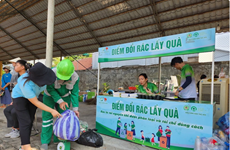National Park to receive funding for development
A master plan to conserve the environment and build infrastructure in
Quang Binh province's Phong Nha–Ke Bang National Park by 2030 has just
been announced in Dong Hoi city.
A master plan to conserve the environment and build infrastructure in
Quang Binh province's Phong Nha–Ke Bang National Park by 2030 has just
been announced in Dong Hoi city.
The plan aims to conserve the park's pristine state and promote eco-tourism.
The park, located 50km northwest of Dong Hoi city, covers a total area of more than 344,000ha, stretching across the three districts of Bo Trach and Minh Hoa.
The master plan will cover 40,860ha in six communes of Bo Trach district, where there will be restricted areas that will not allow mass tourism but small-group tourist activities such as discovering caves, trekking on mountains, exploring jungles on bikes, and jogging in jungles, besides watching animals at night. Some main roads will be built for special tourist vehicles, but there will be no overnight accommodation in these areas. Tourist facilities will be developed in the buffer zone, where proper infrastructure will be built.
According to the plan, boat tourism and trekking along natural trails to popular caves such as Thien Duong, Phong Nha, Tien Son and Son Doong will be promoted.
Buildings for management work, scientific research and tourism services in the buffer zone will be built with environment-friendly technology.
The plan also mentions solutions to prevent flooding in the area by frequent dredging of the rivers' bed and planting of more trees, and processing of sewage and rubbish with biological methods.
However, the master plan does not mention building a zipline to Son Doong Cave.
"We have fulfilled the conservation task in the park during the past ten years," Nguyen Huu Hoai, Chairman of Quang Binh People's Committee, told Vietnam News. "Next month, the Government will submit a dossier to UNESCO to seek its recognition for the park as a world natural heritage in terms of biological diversity."
Deputy Construction Minister Nguyen Dinh Toan said the province should have an effective way to highlight the heritage site and turn it into a top-ranked ecotourism site in Asia, facilitating the socio-economical development of the province and the central region.
In 2003, the park was recognised as a UNESCO World Heritage Site, as it is an "outstanding example representing major stages of earth's history, including the record of life, significant ongoing geological processes in the development of landforms, or significant geomorphic or physiographic features".
The park contains 300 caves that have been explored. Many of them are listed on tourism routes.
Pham Thi Nham, Vice Rector of the Vietnam Institute for Urban and Rural Planning that is responsible for making the master plan, said many buildings had been built by locals along the River Son without any sanction.
"The uncontrolled construction will harm the surrounding environment in the near future," she warned.
Deputy Construction Minister Toan said the most important mission in the master plan was to protect heritage, from which would follow development of heritage value in tourism.
The ministry will co-ordinate with Quang Binh authorities to implement the plan.
It is estimated that the park will receive around 1,350,000 tourists a year by 2030, 55,000 of whom will be foreigners.-VNA
The plan aims to conserve the park's pristine state and promote eco-tourism.
The park, located 50km northwest of Dong Hoi city, covers a total area of more than 344,000ha, stretching across the three districts of Bo Trach and Minh Hoa.
The master plan will cover 40,860ha in six communes of Bo Trach district, where there will be restricted areas that will not allow mass tourism but small-group tourist activities such as discovering caves, trekking on mountains, exploring jungles on bikes, and jogging in jungles, besides watching animals at night. Some main roads will be built for special tourist vehicles, but there will be no overnight accommodation in these areas. Tourist facilities will be developed in the buffer zone, where proper infrastructure will be built.
According to the plan, boat tourism and trekking along natural trails to popular caves such as Thien Duong, Phong Nha, Tien Son and Son Doong will be promoted.
Buildings for management work, scientific research and tourism services in the buffer zone will be built with environment-friendly technology.
The plan also mentions solutions to prevent flooding in the area by frequent dredging of the rivers' bed and planting of more trees, and processing of sewage and rubbish with biological methods.
However, the master plan does not mention building a zipline to Son Doong Cave.
"We have fulfilled the conservation task in the park during the past ten years," Nguyen Huu Hoai, Chairman of Quang Binh People's Committee, told Vietnam News. "Next month, the Government will submit a dossier to UNESCO to seek its recognition for the park as a world natural heritage in terms of biological diversity."
Deputy Construction Minister Nguyen Dinh Toan said the province should have an effective way to highlight the heritage site and turn it into a top-ranked ecotourism site in Asia, facilitating the socio-economical development of the province and the central region.
In 2003, the park was recognised as a UNESCO World Heritage Site, as it is an "outstanding example representing major stages of earth's history, including the record of life, significant ongoing geological processes in the development of landforms, or significant geomorphic or physiographic features".
The park contains 300 caves that have been explored. Many of them are listed on tourism routes.
Pham Thi Nham, Vice Rector of the Vietnam Institute for Urban and Rural Planning that is responsible for making the master plan, said many buildings had been built by locals along the River Son without any sanction.
"The uncontrolled construction will harm the surrounding environment in the near future," she warned.
Deputy Construction Minister Toan said the most important mission in the master plan was to protect heritage, from which would follow development of heritage value in tourism.
The ministry will co-ordinate with Quang Binh authorities to implement the plan.
It is estimated that the park will receive around 1,350,000 tourists a year by 2030, 55,000 of whom will be foreigners.-VNA













